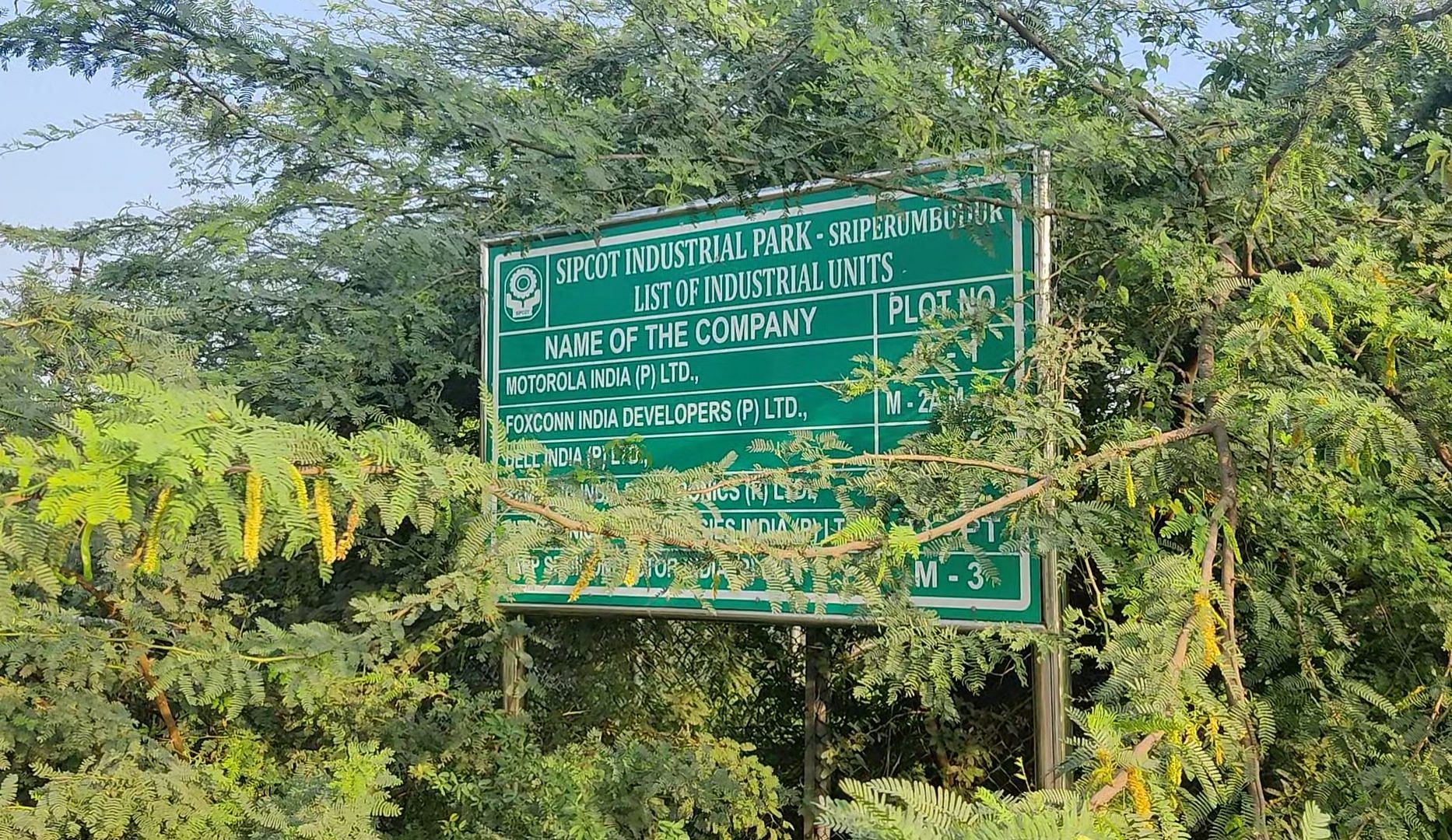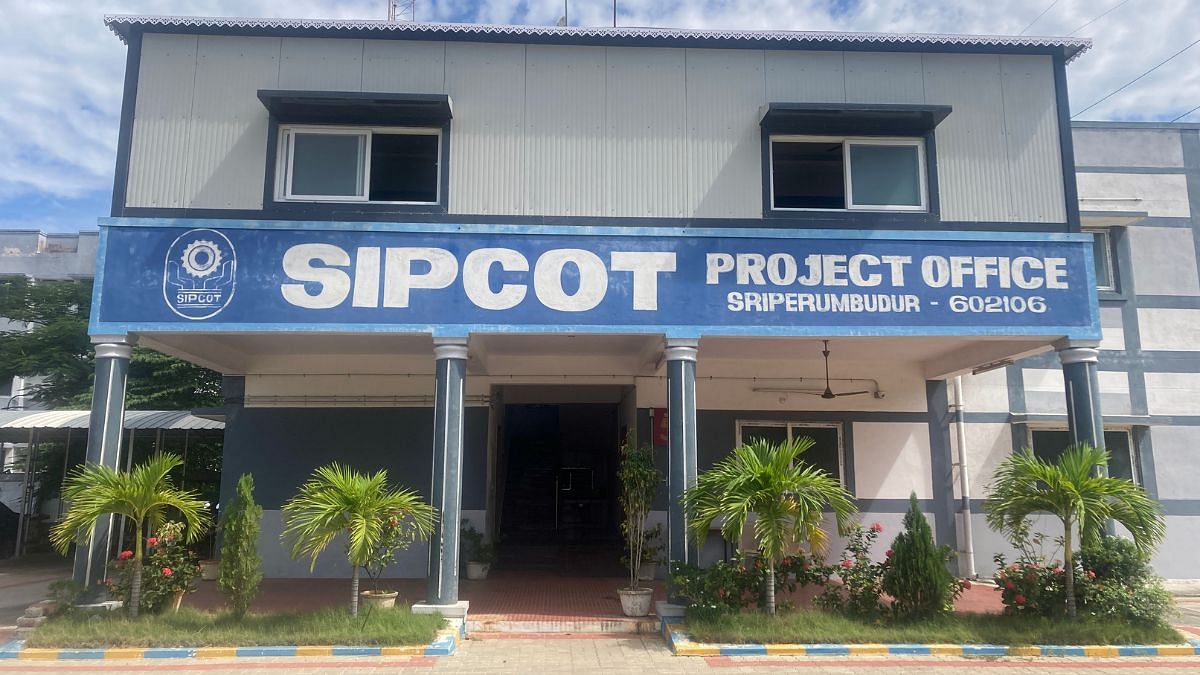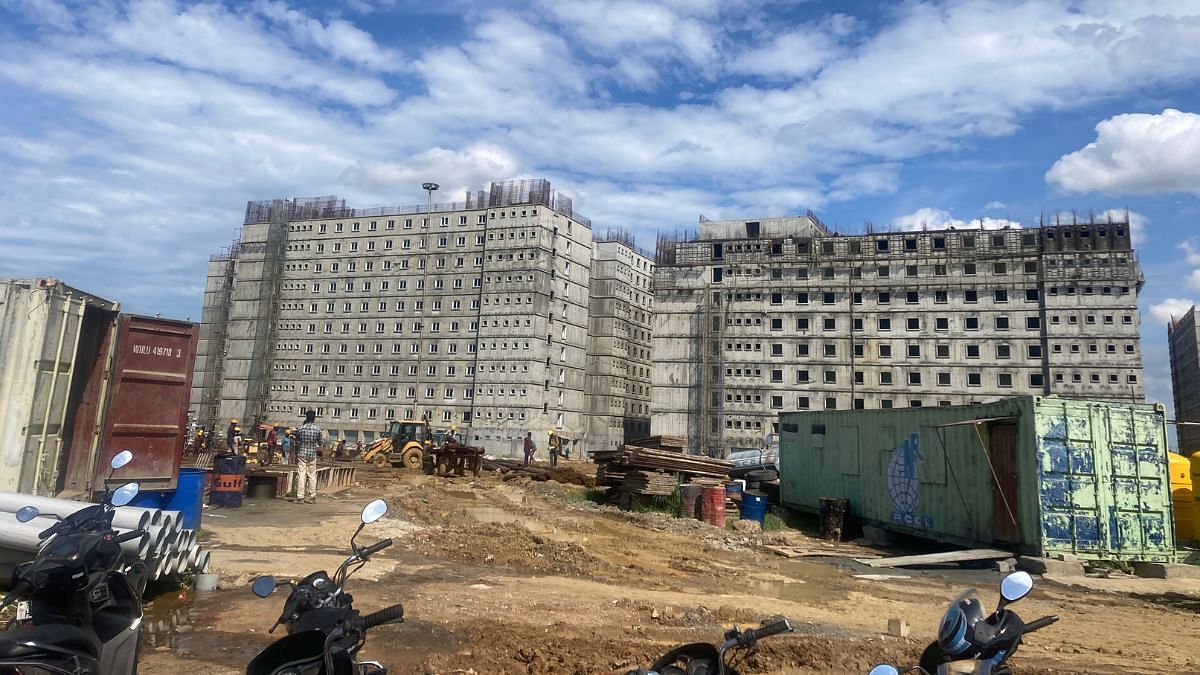Sriperumbudur: If Kavya could own one of the iPhones that she assembles, it would be a black one. But this dream of hers won’t be realised anytime soon. For now, she is busy pursuing a national dream.
Kavya is one of thousands of workers assembling iPhones—the most recent models in red, yellow, blue, purple, white, black—at the huge Foxconn factory in Tamil Nadu’s Sriperumbudur. The town is one of Apple’s most important assembly hubs outside China. Its new flex is set to wipe away the blood-soaked image that characterised what was once a site of national mourning where former Prime Minister Rajiv Gandhi was assassinated.
Now, Sriperumbudur has become India’s electronics capital, and an important link in the global supply chain. From Foxconn to Ford and Samsung to Saint-Gobain, the town’s industrial parks are where the world’s topmost companies have chosen to set up a base.
And the geopolitics is trickling down to the factory floor. Women are leading what looks like the next phase of the flat world.
Their nimble fingers assemble small electronics parts for eight hours a day, six days a week. They have hourly targets of assembling iPhones, and the pressure to meet those targets is intense, amplified by the surge in global demand for iPhones. They work against time through punishing schedules to meet Apple customers’ high demands, assembling over 30,000 iPhones a day.
“It’s not bad work. Our main concern is that we don’t get enough time off, and the work also affects our health”
—Aruna, a 28-year-old engineer
They have an inkling that their work is a lot more than just making cell phones. But only because Indian news channels and newspapers haven’t stopped declaring it from the rooftops.
“I saw on the news that our company has shifted here from China, and that electronics is taking India to the next level,” said Aruna, 28, a civil engineer. “It feels good, but I don’t know too much about that. It’s all very good that they’re focusing on the future. We are just focusing on our futures too.”
In Sriperumbudur’s success lies the story of two competitions: the Western world’s push to turn India into a counter to China; and Tamil Nadu’s own heady growth story that could leave much of northern India behind.

Over the past three decades, Tamil Nadu has emerged as the new electronics manufacturing hub, with several companies setting up factories as part of the China + 1 strategy. Tamil Nadu is the most industrialised state in India with the second-largest economy in the country. It already has the social infrastructure required for a manufacturing hub to take off, offering global companies a diverse and inclusive blueprint to build on. And it has the talent to match: of India’s 1.6 million female factory workers, 43% are in Tamil Nadu. It’s a huge number that the state is proud of — and Sriperumbudur’s electronics industry is where many of them work.
‘If it’s good for Apple, it’s good for the world’ is the postcard India wants to send out, much like the 1970s, when Mercedes Benz’ manufacturing began.
“We’re engineering a better society in Tamil Nadu, which is inclusive and equitable,” said TRB Rajaa, Minister for Industries, Investment Promotions and Commerce in the state government. “For a healthy economy, women’s labour participation is very important. A happy home leads to a happy state.”
Huge signs announce Sriperumbudur and its adjoining Special Economic Zones, just off the busy Bengaluru-Chennai highway. The green expanse is broken by towering grey factories, each larger than the last, accompanied by huge signboards announcing which multinational companies occupy them. Signs of life are tucked behind huge walls, with buses ferrying workers in and out of them, 24 hours a day.
And behind each factory complex’s high gates, workers are busy building India’s future. It’s not just iPhones, but ‘Made in India’ dreams are being manufactured here.

Working women of the future
A significant majority of the women hired to work in Sriperumbudur’s large factories are well-educated. In fact, many women graduates with engineering degrees wind up on the factory floor here. Those who are not graduates have at least participated in skill development programmes offered by the Tamil Nadu government.
However, the first question they are asked during interviews for electronics jobs is whether they are married or not.
Educated, unmarried, young women are highly sought-after as a workforce for such companies. They come from faraway villages in Tamil Nadu, leaving their families behind to reside in fortified workers’ hostels for a monthly salary ranging from Rs 15,000 to Rs 20,000.
“It’s not bad work,” says Aruna, who oversees the assembly line on a conveyor belt. “Our main concern is that we don’t get enough time off, and the work also affects our health.”
Beyond the competition with China, there’s a growing sense that Tamil Nadu is leaving the rest of India behind.
Sitting on steel chairs bent for hours on end at a conveyor belt has led to a range of health problems—spondylitis and back pain, similar to the issues faced by urban workers who spend all day at keyboards. Taking a sick day means losing a day’s pay, and if they take three days off, they are termed absconders. These women also struggle to work through period cramps, headaches, hair loss, and kidney stones.
But it is still work. And they need the money.
White buses ferry workers in and out of the factory parks, while vigilant security guards monitor their movements. Construction continues unabated despite the sticky heat. Buses and trucks hurtle down the highway, transporting people and goods between the metropolitan cities of Chennai and Bengaluru. Those who live on the factory campus rarely venture outside of it.
“India still has an image of being a difficult country to work in. It must undo this image of being a hostile place for investors. It’s not the money or subsidies you give that makes the difference; it’s the friendliness of the state and its employees”
—Gurcharan Das, author
Workers avoid making eye contact with strangers, and the only women seen leaving and entering on foot are the housekeeping staff, all hailing from local villages and wearing blue uniforms. They travel in shared auto-rickshaws, chatting and laughing during their daily commute back home.
“There’s a noticeable shift in how today’s workforce interacts with their work,” said labour lawyer Shreela Manohar, pointing to the secrecy that shrouds what’s happening inside the factories. “There’s a sense of detachment that the female workforce is feeling. These are young, educated women with degrees, yet they are subjected to multiple layers of invisibilisation that is reducing them simply to the number of seconds they take to assemble something.”

The China+1 strategy
The rising tide of industrial geopolitics has lifted Sriperumbudur’s boat. Multinational companies are embracing a China+1 strategy to diversify their production capabilities, especially in the wake of the havoc caused by the pandemic.
India has been a hot foreign investment destination for three decades, but now, there’s a strategic rationale behind this interest. India possesses the necessary workforce and a highly successful service sector. ‘If it’s good for Apple, it’s good for the world’ is the postcard India wants to send out, much like the sentiment expressed when Mercedes Benz manufacturing began in the 1970s.
But even if the world is ready, is India really ready?
“India hasn’t had an industrial revolution yet. It’s not going to be easy. There’s a lot going in India’s favour, but we still need to do plenty of reforms,” said author Gurcharan Das. “Foxconn and Apple coming to India is a good development, because it will influence other companies to come and manufacture here. Our profit-linked incentive schemes should incentivise exports, job creation, and bring component manufacturers here. Only then can India take off as a manufacturing destination.”

Beyond the competition with China, there’s a growing sense that Tamil Nadu is leaving the rest of India behind.
Das pointed out the healthy competition not just among various Asian countries but also among Indian states jostling to attract investments. Tamil Nadu, Gujarat, and Maharashtra have been far more successful than other states, and there are valuable lessons to be learned from their experiences.
“With its history of industrialisation, Tamil Nadu could act quickly, because it has already invested in infrastructure and enacted land and labour-related policies, which it could easily offer to global capital,” said Madhumita Dutta, assistant professor at the Ohio State University, who has extensively studied the Nokia plant in Sriperumbudur.
Today, Tamil Nadu’s trajectory is often referred to as the ‘Dravidian model of growth’, much like the famed Gujarat model.
The southern state gained a head start in the 1990s when it attracted the Ford Motor factory, beating out other automobile industry states like Maharashtra. Then came Nokia, cementing Tamil Nadu’s reputation as an investment-friendly and industry-friendly state. Nokia was an important turning point, because it brought Foxconn as a vendor. Today, Tamil Nadu’s trajectory is often referred to as the ‘Dravidian model of growth’, much like the famed Gujarat model.
“Tamil Nadu had a similar experience in 2005 with the arrival of Nokia,” said Prof Dutta. “The question now is, what has the state learned, and what is it doing differently?”
According to Tamil Nadu’s industries minister Rajaa, the state has already created the necessary social infrastructure for industries to flourish. “This didn’t happen overnight,” he added. “Incentives can be thrown around, but delivering on incentives is something Tamil Nadu has done well.”
And increasing women’s labour participation is part of this drive. Claudia Goldin, who won the 2023 Nobel Prize in Economics for studying women’s participation in the workforce, found that industrialisation kept women out of the workforce as married women began to drop out, while only unmarried women worked in manufacturing. This trend changed with the advent of the services sector and the increase in education.
“India hasn’t had an industrial revolution yet. It’s not going to be easy. There’s a lot going in India’s favour, but we still need to do plenty of reforms”
—Gurcharan Das, author
In Tamil Nadu, which has the highest female labour force participation in India among large states, the labour force participation was preceded by a number of policy measures for gender equality—from measures to prevent female infanticide, all-women police stations, dedicated buses for women. A recent scheme also gives Rs.1000 to women who work as “homemakers” — acknowledging the exact kind of domestic labour that is unaccounted for in most economic surveys, according to Goldin. It’s called Kalaignar Magalir Urimai Thittam, translating to the “right of women” to earn.
But underemployment is still an issue for educated Tamil women.
So now, the state’s focus is on enhancing research capabilities. Rajaa says that the Tamil Nadu government has cultivated talent and is determined to bolster research capabilities to ultimately become the knowledge capital of South Asia. “It’s not just increasing investments, we want to have patents here,” he emphasised.
This results-driven approach is a strategy that should be applied by all states, according to Rajaa—not just industrial hubs like Tamil Nadu, Gujarat, and Maharashtra.
“As a nation, we should go for geostrategic manufacturing and play to our strengths. The government of India should empower every state to work to capitalise on its strengths,” said Rajaa. “We’re not seeing any other state as competition.”
The Dravidian model
The history—or perhaps the future—of the electronics industry in Sriperumbudur begins with Nokia.
“Go, get Nokia,” announced then-Chief Minister Jayalalithaa to her officials in 2004. She had reportedly come across news reports that Nokia was scouting locations in India to set up a manufacturing plant, and several states, including Haryana, Andhra Pradesh, Uttarakhand, Karnataka, and Maharashtra, were vying for the opportunity.
Tamil Nadu emerged victorious: not only did Nokia set up its largest factory in Sriperumbudur, but it heralded the beginning of a new manufacturing dawn.
Shortly thereafter, the Tamil Nadu Special Economic Zone (SEZ) Act was enacted in 2005, streamlining the path for industries to fast-track their growth — including those in Sriperumbudur. This was facilitated by the State Industries Promotion Corporation of Tamil Nadu (SIPCOT), conceived by the DMK and established in 1971. The corporation was instrumental in developing industrial complexes for major investors and, along with other bodies like Tamil Nadu Industrial Development Corporation Ltd (TIDCO), transformed the industrial infrastructure in the state. SIPCOT has created 24 industrial complexes across 15 districts and established six sector-specific SEZs.
As a result, Tamil Nadu now accounts for 20% of electronics production in India, and it boasts a highly diversified manufacturing sector, encompassing automobiles, textiles, and leather products.
Sriperumbudur’s SEZ has grown into multiple industrial parks, including the SIPCOT park, Oragadam Industrial Park, and the Irungattukottai Industrial Park. Companies like Hyundai, Nokia, Samsung, and Motorola have set up shops there, along with other Fortune 500 companies such as Saint-Gobain, Dell, Ford, BMW, and Foxconn.
Within the SEZ, Foxconn occupies 150 acres, Dell has 50 acres, Samsung covers 80 acres, and Flextronics possesses 100 acres. Around 70,000 people are employed in this area, with Foxconn accounting for 30% of the workforce, according to Sriperumbudur’s SIPCOT project manager, Sakthivel.
Now, however, available land has been exhausted, leaving no room for further expansion. Growth can only occur from the ground up, and the current focus is on improving living conditions — if not working conditions — for the thousands of workers employed in the perimeter. Sakthivel is currently overseeing the construction of a vast hostel designed to accommodate 18,000 workers.

“We do have better working conditions compared to the other industrial belts like Tirupur and Coimbatore, because the nature of the industry is better,” he said. “But there is always room for improvement.”
The next big town?
Sriperumbudur may have the reputation, but it hasn’t achieved the bustling, boom-town look yet.
Unlike places like Noida or Bengaluru’s Electronic City, this town hasn’t experienced the same rapid development, but its proximity to Chennai provides a convenient compromise. Located on the Bengaluru-Chennai highway, it holds the promise of becoming a glittering pitstop. But it’s not there yet — and the state of the highway remains a bugbear for all who travel on it.
Interestingly, the excitement about Sriperumbudur is greater outside the town than within. Apple production is a needle-shifting, quantum-leap moment for India’s global ambitions. But this drab, dry, dusty town has some catching up to do.
“In India, we should be asking ourselves why other countries like Vietnam are seen as more hospitable,” said Das. “India still has an image of being a difficult country to work in. It must undo this image of being a hostile place for investors. It’s not the money or subsidies you give that makes the difference — it’s the friendliness of the state and its employees.”

Women’s aspirations
Working at an Apple factory may sound cool, but it is not necessarily the pinnacle of the workers’ ambitions here. Many of them would prefer to work in the IT sector.
The romanticisation of factory work is not a new phenomenon. Plenty of reportage in the early 2000s painted a rosy picture of the future. However, behind the cosy smokescreen of women’s emancipation lay the darker reality of exploitation, particularly in the case of Nokia.
A murky history of labor activism has left a bitter taste in everyone’s mouths. In 2021, when a food poisoning outbreak forced Foxconn employees to hit the streets in protest, many workers found themselves blacklisted from further employment. Numerous working women left Sriperumbudur, sacrificing their financial independence for the safety of their parents’ homes.
That was two years ago. A government-led inspection revealed safety risks and multiple labour violations, which Foxconn reportedly addressed under Apple’s oversight. The factory remained closed for a month, and a phased reopening began in January 2022.
However, the damage was minimal, even as rumours settled into the factory’s reputation. The bottom line is that workers need work, and young women graduates were more than willing to fill that gap.
“Most of us heard about Foxconn from our friends,” said Divya, a 24-year-old with a degree in computer applications. She would prefer to work in IT but is happy for now. “It’s good money.”
And there is pride in working for such a global brand. Seema doesn’t mind the hard work because she knows it’s essential to meet Apple customer’s demands. She does quality assessment — checking things like dust levels and assembly precision — and is angling to put her engineering degree to use and become a technician on the factory floor.
“I want to work with machines and not my hands. But I have to keep an eye on what’s happening because if the process goes wrong, then everything has to be repeated, which delays the product,” she explained. “If the product is delayed, how will customers trust the brand?”
The work in the IT industry is less menial, and the pay is better, according to 23-year-old Isha. She lives in a government-run working women’s hostel, Thozhi Hostels, and is actively seeking an IT job. She observes her hostel-mates heading off to their shifts at electronic companies and draws comparisons between them and the hostel residents employed in IT companies like Zoho and Accenture.
“The work is better at an IT company because I can use my computer applications degree,” she said. “But the standard of life is more posh, I think. I’ve noticed how all my friends have suddenly changed their fashion style and developed accents.”
According to Isha and her friend Rashmi, who works at an electronics company, the starting package at an IT company is around Rs 25,000, with promotions every six months. In contrast, climbing up the ladder from the factory floor is considerably more difficult. Work in electronics is repetitive and precise, always confined within the factory walls.
“The main difference is money,” said Rashmi. “So everyone becomes fancier in IT.”
Some of the Foxconn workers agree — saying it’s natural to feel ‘limited’ working at conveyor belts. One wants to move to IT and work with computers, while another wants to branch off into marine engineering. Kavya initially wanted to become a nurse, and her friend had aspired to become an English teacher.
But their ambitions are currently on hold because making money is the need of the hour. So they settle into their work life, with their primary complaints being the long hours and the health issues they face. They can’t wear clothes that are too short or too long and flowing, and also have to take off all metal jewellery.
Though these factories have hostels within their premises, several women opt to stay in private hostels outside. They get more freedom — and they can avoid the subpar food.
The women who reside on the factory campus rarely go beyond its walls.
“Those poor girls never leave!” said Poongudi, who lives in a village within the Sriperumbudur SEZ and works as housekeeping staff in a Foxconn factory hostel. “I know, they’re always saying iPhone, iPhone, iPhone. But I don’t know what else they do!”
(Names of workers have been changed to protect their identity)
(Edited by Prashant)



